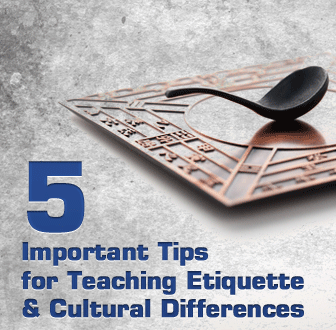Cultural Diversity in the Classroom: 5 Useful Tips on How to Teach Students from Different Cultures


If you are in a uni-cultural class, there is still a lot you can do regarding teaching the etiquette of different countries as well as cultural differences. After all, you are a culture representative for your country and students will want to learn all they can about you and where you come from. Being politically correct is a new concept to a lot of students and depending on where you are, it may be a sensitive issue. Follow these tips for teaching etiquette and cultural differences and your mixing pot of a classroom will reap numerous benefits from sharing and learning together.

It is essential to create a culturally appropriate and courteous environment from the very first moment of class. One way to do this is to acknowledge everyone’s cultures, and get students talking immediately, in a non-threatening way, about themselves and their countries of origin. One fantastic ice-breaker for multi-cultural classrooms is a find someone who mingling exercise that is tailored to include a few statements to reflect the cultural diversity of the class, with things like, find someone who…
- is from Central America
- eats rice on a daily basis
- speaks Korean
- etc.
You’ll really want to target benign topics which are easy to ask about and easy to discuss. Another ice-breaker you can do is to start a discussion with the class utilizing a map. If you have people from many different countries, they can show the rest of the group where they are from on the map and then talk about things like their language, a famous country food, or other culturally significant information. The point is to create an environment from the first class forward that enables students to talk about culture, differences, and themselves in an appropriate way.
There are several ways in which you can bring culture and etiquette into your lessons without it being the sole topic. One easy way to do that is to consistently make comparisons about the differences from country to country with topics that arise organically. If you are talking about greetings, for example, a good way to solidify what students are learning is to ask them the equivalent in their country’s language. Ask them the appropriate and polite ways that they greet one another. Do men hug, shake, wave or something else? If you are the one in a foreign country, a major way to engage students is to ask for their advice on matters of cultural norms and etiquette. If you are doing a lesson on telling time, you can then get into a discussion about the cultural norms of their country. How appropriate is it to be late? When meeting friends from this country, what can you expect about time in general? Students will be more than happy to share information from their culture to help you navigate it. A third way to bring in comparisons is for you to share how something is done in your country. If you are discussing small talk, for example, you can provide examples of how people in your country handle small talk and what the nuances are. Follow that up with students then interjecting their thoughts, questions and comparisons.
It is especially important and of noted significance to use your classroom as an outlet for students to share things about their heritage, culture and daily life. There are several opportunities where you can showcase culture and discuss differences as well as similarities. Some of the best topics that naturally lead to cultural discussions and activities are: food, nationalities and countries, family, and modal verbs. When approaching topics from a cultural standpoint, etiquette will almost inherently arise. If you are discussing food from a specific region, you can also approach all kinds of other topics as well. Some examples might be: timing of meals, normal ingredients or very usual foods, the role of alcohol, meanings of particular foods or ceremonies, etc. You can get creative and assign students presentations on one or more aspects of their culture, plan a pot-luck party or recipe exchange, or design some other way in which students share their differing beliefs and experiences. One goal of expounding upon differences is to find, in the end, that we are not all that different, and that we must display tolerance and acceptance. Students can learn a lot simply from listening to each other, and having the forum to do so.
If you are teaching in a westernized country where the students may be visiting or very new arrivals, you and the class could very well become their guide in navigating a new culture. In this situation it becomes even more vital to explain cultural norms, especially when it comes to etiquette and acceptable behavior. The above examples still hold true, but there may need to be more structured lessons around things like currency, riding the bus, polite responses, asking questions, and interacting with strangers. Often once students become comfortable in the class, they will begin asking their classmates for help, as well as the teacher. Be sure that you are setting good examples within the classroom and with your own behavior, as well as enforcing appropriate behavior among your students. The dynamic of entering a new culture with limited language can be exciting, but it can also be daunting and isolating at times. Everyone in the class can benefit from hearing different perspectives. Creating an environment where students can voice their difficulties and concerns will assist the class on a whole.
When approaching etiquette and cultural awareness, it is always a good idea to have an open mind, let your creativity guide you, and above all, provide students with appropriate outlets to express themselves!